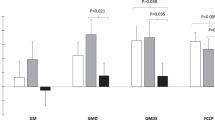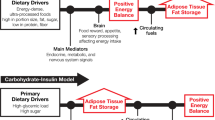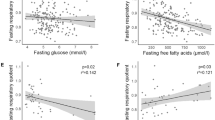Abstract
The ‘carbohydrate-insulin theory of obesity’ is used to justify popular health claims stating that carbohydrates make you fat or a high glycemic load and consumption of sugar-sweetened beverages (SSBs) and breakfast skipping increase fat gain. According to this theory, the elevated postprandial insulin secretion to a high glycemic challenge is blamed as a causal mechanism by directing nutrients away from oxidation in muscle towards storage in adipose tissue. Scientific evidence is however largely disagreeing with an adverse effect of postprandial hyperinsulinemia on fuel partitioning. Possible reasons for this disagreement are differences in insulin sensitivity and energy balance. Diet-induced hyperinsulinemia may lead to a higher fat storage only at a positive energy balance. A shift in fuel partitioning towards fat storage requires improved or maintained insulin sensitivity in adipose tissue when compared with skeletal muscle. This may be the case during refeeding (after weight loss), physical inactivity or in metabolically healthy obese subjects (relative to insulin-resistant subjects). The adverse effect of a high-glycemic diet, SSBs consumption or breakfast skipping on body weight is likely due to increased energy consumption rather than to increased fat storage.
This is a preview of subscription content, access via your institution
Access options
Subscribe to this journal
Receive 12 print issues and online access
$259.00 per year
only $21.58 per issue
Buy this article
- Purchase on Springer Link
- Instant access to full article PDF
Prices may be subject to local taxes which are calculated during checkout
Similar content being viewed by others
References
Forbes GB . Lean body mass-body fat interrelationships in humans. Nutr Rev 1987; 45: 225–231.
Saltiel AR . Insulin signaling in the control of glucose and lipid homeostasis. Handb Exp Pharmacol 2016; 233: 51–71.
Boulé NG, Chaput JP, Doucet E, Richard D, Després JP, Bouchard C et al. Glucose homeostasis predicts weight gain: prospective and clinical evidence. Diabetes Metab Res Rev 2008; 24: 123–129.
Froidevaux F, Schutz Y, Christin L, Jéquier E . Energy expenditure in obese women before and during weight loss, after refeeding, and in the weight-relapse period. Am J Clin Nutr 1993; 57: 35–42.
Ludwig D . The glycemic index: physiological mechanisms relating to obesity, diabetes, and cardiovascular disease. JAMA 2002; 287: 2414–2423.
Díaz EO, Galgani JE, Aguirre CA . Glycaemic index effects on fuel partitioning in humans. Obes Rev 2006; 7: 219–226.
TeMorenga L, Mallard S, Mann J . Dietary sugars and body weight: systematic review and meta-analyses of randomised controlled trials and cohort studies. BMJ 2012; 346: e7492.
Cettour-Rose P, Samec S, Russell AP, Summermatter S, Mainieri D, Carrillo-Theander C et al. Redistribution of glucose from skeletal muscle to adipose tissue during catch-upfat: a link between catch-up growth and later metabolic syndrome. Diabetes 2005; 54: 751–756.
Casimir M, de Andrade PB, Gjinovci A, Montani JP, Maechler P, Dulloo AG . A role for pancreatic beta-cell secretory hyperresponsiveness in catch-up growth hyperinsulinemia: relevance to thrifty catch-upfat phenotype and risks for type 2 diabetes. Nutr Metab (Lond) 2011; 8: 2.
Kahlhöfer J, Lagerpusch M, Enderle J, Eggeling B, Braun W, Pape D et al. Carbohydrate intake and glycemic index affect substrate oxidation during a controlled weight cycle in healthy men. Eur J Clin Nutr 2014; 68: 1060–1066.
Reichkendler MH, Auerbach P, Rosenkilde M, Christensen AN, Holm S, Petersen MB et al. Exercise training favors increased insulin-stimulated glucose uptake in skeletal muscle in contrast to adipose tissue: a randomized study using FDG PET imaging. Am J Physiol Endocrinol Metab 2013; 305: E496–E506.
Alibegovic AC, Højbjerre L, Sonne MP, van Hall G, Stallknecht B, Dela F et al. Impact of 9 days of bed rest on hepatic and peripheral insulin action, insulin secretion, and whole-body lipolysis in healthy young male offspring of patients with type 2 diabetes. Diabetes 2009; 58: 2749–2756.
Lagerpusch M, Enderle J, Eggeling B, Braun W, Johannsen M, Pape D et al. Carbohydrate quality and quantity affect glucose and lipid metabolism during weight regain in healthy men. J Nutr 2013; 143: 1593–1601.
Lagerpusch M, Enderle J, Later W, Eggeling B, Pape D, Müller MJ et al. Impact of glycaemic index and dietary fibre on insulin sensitivity during the refeeding phase of a weight cycle in young healthy men. Br J Nutr. 2013; 109: 1606–1616.
Kahlhöfer J, Karschin J, Silberhorn-Bühler H, Breusing N, Bosy-Westphal A . Effect of low-glycemic-sugar-sweetened beverages on glucose metabolism and macronutrient oxidation in healthy men. Int J Obes (Lond) 2016; 40: 990–997.
Del Prato S, Leonetti F, Simonson DC, Sheehan P, Matsuda M, DeFronzo RA . Effect of sustained physiologic hyperinsulinaemia and hyperglycaemia on insulin secretion and insulin sensitivity in man. Diabetologia 1994; 37: 1025–1035.
Jensen CB, Storgaard H, Holst JJ, Dela F, Madsbad S, Vaag AA . Insulin secretion and cellular glucose metabolism after prolonged low-grade intralipid infusion in young men. J Clin Endocrinol Metab 2003; 88: 2775–2783.
Kelley DE . Skeletal muscle fat oxidation: timing and flexibility are everything. J Clin Invest 2005; 115: 1699–1702.
Galgani JE, Heilbronn LK, Azuma K, Kelley DE, Albu JB, Pi-Sunyer X et al. Look AHEAD Adipose Research Group. Metabolic flexibility in response to glucose is not impaired in people with type 2 diabetes after controlling for glucose disposal rate. Diabetes 2008; 57: 841–845.
Muoio DM . Metabolic inflexibility: when mitochondrial indecision leads to metabolic gridlock. Cell 2014; 159: 1253–1262.
Isken F, Klaus S, Petzke KJ, Loddenkemper C, Pfeiffer AF, Weickert MO . Impairment of fat oxidation under high- vs. low-glycemic index diet occurs before the development of an obese phenotype. Am J Physiol Endocrinol Metab 2010; 298: E287–E295.
Pawlak DB, Kushner JA, Ludwig DS . Effects of dietary glycaemic index on adiposity, glucose homoeostasis, and plasma lipids in animals. Lancet 2004; 364: 778–785.
Tremblay A, Boulé N, Doucet E, Woods SC . Is the insulin resistance syndrome the price to be paid to achieve body weight stability? Int J Obes (London) 2005; 29: 1295–1298.
Gower BA, Hunter GR, Chandler-Laney PC, Alvarez JA, Bush NC . Glucose metabolism and diet predict changes in adiposity and fat distribution in weight-reduced women. Obesity (Silver Spring) 2010; 18: 1532–1537.
Yost TJ, Jensen DR, Eckel RH . Weight regain following sustained weight reduction is predicted by relative insulin sensitivity. Obes Res 1995; 3: 583–587.
Piaggi P, Thearle MS, Bogardus C, Krakoff J . Fasting hyperglycemia predicts lower rates of weight gain by increased energy expenditure and fat oxidation rate. J Clin Endocrinol Metab 2015; 100: 1078–1087.
Larger E . Weight gain and insulintreatment. Diabetes Metab 2005; 31: 4S51–4S56.
Bosy-Westphal A, Wolf A, Bührens F, Hitze B, Czech N, Mönig H et al. Familial influences and obesity-associated metabolic risk factors contribute to the variation in resting energy expenditure: the Kiel Obesity Prevention Study. Am J Clin Nutr 2008; 87: 1695–1701.
Sartor F, Jackson MJ, Squillace C, Shepherd A, Moore JP, Ayer DE et al. Adaptive metabolic response to 4 weeks of sugar-sweetened beverage consumption in healthy, lightly active individuals and chronic high glucose availability in primary human myotubes. Eur J Nutr. 2013; 52: 937–948.
Stanhope KL, Schwarz JM, Keim NL, Griffen SC, Bremer AA, Graham JL et al. Consuming fructose-sweetened, not glucose-sweetened, beverages increases visceral adiposity and lipids and decreases insulin sensitivity in overweight/obese humans. J Clin Invest 2009; 119: 1322–1334.
Cox CL, Stanhope KL, Schwarz JM, Graham JL, Hatcher B, Griffen SC et al. Consumption of fructose-sweetened beverages for 10 weeks reduces net fat oxidation and energy expenditure in overweight/obese men and women. Eur J ClinNutr 2012; 66: 201–208.
Karl JP, Roberts SB, Schaefer EJ, Gleason JA, Fuss P, Rasmussen H et al. Effects of carbohydrate quantity and glycemic index on resting metabolic rate and body composition during weight loss. Obesity (Silver Spring) 2015; 23: 2190–2198.
Pereira MA, Swain J, Goldfine AB, Rifai N, Ludwig DS . Effects of a low-glycemic load diet on resting energy expenditure and heart disease risk factors during weight loss. JAMA 2004; 292: 2482–2490.
Das SK, Gilhooly CH, Golden JK, Pittas AG, Fuss PJ, Cheatham RA et al. Long-term effects of 2 energy-restricted diets differing in glycemic load on dietary adherence, body composition, and metabolism in CALERIE: a 1-y randomized controlled trial. Am J Clin Nutr 2007; 85: 1023–1030.
Magkos F, Fraterrigo G, Yoshino J, Luecking C, Kirbach K, Kelly SC et al. Effects of moderate and subsequent progressive weight loss on metabolic function and adipose tissue biology in humans with obesity. Cell Metab 2016; 23: 591–601.
Fabbrini E, Yoshino J, Yoshino M, Magkos F, TiemannLuecking C, Samovski D et al. Metabolically normal obese people are protected from adverse effects following weight gain. J Clin Invest 2015; 125: 787–795.
Timmers S, Nabben M, Bosma M, van Bree B, Lenaers E, van Beurden D et al. Augmenting muscle diacylglycerol and triacylglycerol content by blocking fatty acid oxidation does not impede insulin sensitivity. Proc Natl Acad Sci USA 2012; 109: 11711–11716.
Ali AH, Mundi M, Koutsari C, Bernlohr DA, Jensen MD . Adipose tissue free fatty acid storage in vivo: effects of insulin versus niacin as a control for suppression of lipolysis. Diabetes 2015; 64: 2828–2835.
Frayn K . Metabolic Regulation: A Human Perspective. Wiley-Blackwell: Oxford, 2010 p. 384.
Mandarino LJ, Wright KS, Verity LS, Nichols J, Bell JM, Kolterman OG et al. Effects of insulin infusion on human skeletal muscle pyruvate dehydrogenase, phosphofructokinase, and glycogen synthase. Evidence for their role in oxidative and nonoxidative glucose metabolism. J Clin Invest 1987; 80: 655–663.
Hall KD, Bemis T, Brychta R, Chen KY, Courville A, Crayner EJ et al. Calorie for calorie, dietary fat restriction results in more body fat loss than carbohydrate restriction in people with obesity. Cell Metab. 2015; 22: 427–436.
Taubes G . Why We Get Fat and What to Do About it. Alfred A. Knopf: New York, 2011.
Hall KD, Chen KY, Guo J, Lam YY, Leibel RL, Mayer LE et al. Energy expenditure and body composition changes after an isocaloric ketogenic diet in overweight and obese men. Am J Clin Nutr 2016; 104: 324–333.
Kanaley JA, Heden TD, Liu Y, Fairchild TJ . Alteration of postprandial glucose and insulin concentrations with mealfrequency and composition. Br J Nutr 2014; 112: 1484–1493.
Munsters MJ, Saris WH . Effects of meal frequency on metabolic profiles and substrate partitioning in lean healthy males. PLoS One 2012; 7: e38632.
Brown AW, Bohan Brown MM, Allison DB . Belief beyond the evidence: using the proposed effect of breakfast on obesity to show 2 practices that distort scientific evidence. Am J ClinNutr 2013; 98: 1298–1308.
Author information
Authors and Affiliations
Corresponding author
Ethics declarations
Competing interests
The authors declare no conflict of interest.
Rights and permissions
About this article
Cite this article
Bosy-Westphal, A., Hägele, F. & Nas, A. Impact of dietary glycemic challenge on fuel partitioning. Eur J Clin Nutr 71, 327–330 (2017). https://doi.org/10.1038/ejcn.2016.230
Received:
Accepted:
Published:
Issue Date:
DOI: https://doi.org/10.1038/ejcn.2016.230



